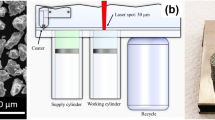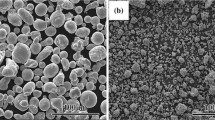Abstract
Recently, porous nickel titanium (NiTi) made from nickel (Ni) and titanium hydride (TiH2) has been used for biomedical implants such as staples due to its pseudo-elastic and shape memory behaviour. Many methods are available to produce porous NiTi such as casting, metal injection moulding process, and additive manufacturing process. The metal injection moulding is one of the famous methods in producing porous NiTi. To obtain a good flowability during the injection process, it is important to find the ideal powder loading before conducting the injection moulding process. In this paper, the critical powder volume percentage (CPVP) and mixing process were discussed to determine the optimum powder loading for the feedstock before conducting the metal injection moulding process. From the calculation, the critical powder loadings for 50.0 at% Ni and 50.4 at% Ni were 69.6% and 71.4%, respectively. The ideal powder loading should be 2% to 5% from the critical powder loading. Therefore, the ideal powder loadings for 50.0 at% Ni was 65.5 and 67.5% vol%, while the ideal powder loadings for 50.4 at% Ni was 67.5 and 69.5 vol%.
Access provided by Autonomous University of Puebla. Download conference paper PDF
Similar content being viewed by others
Keywords
1 Introduction to Porous Nickel Titanium
Nickel titanium (NiTi) has many potential applications in the engineering industry. Due to its unique shape memory effect (SME) and pseudo-elasticity (PE), it can be used as an active, adaptive or a smart structure for biomedical applications [1]. It has been reported that most biomedical materials for bone implant research have been produced by powder metallurgy routes such as metal injection moulding (MIM) [2]. MIM is the best method to produce complex shapes and small parts because it can create a variety of components from metal powders [3]. Most green parts cannot be injected well during the injection moulding process due to the lack of knowledge on powder loading value. To obtain a good flowability during the injection process, it is important to find the ideal powder loading to feed the powder into the barrel. Several methods can be used to determine the critical powder loading such as mixing torque analysis or critical powder volume percentage (CPVP), melt flow density approach, and viscosity versus composition [4]. In this study, CPVP was carried out to determine the critical powder loading before mixing the powder with binder to produce feedstock [5]. A successful injection moulding process could be achieved with a good understanding of powder mixture and the rheology behavior [6].
1.1 Methodology
In this study, the Ni atomic percent of 50 at% and 50.4 at% was used to investigate the optimum powder loading for each composition. The CPVP technique is a modification of ASTM D281-12 for the standard test of oil absorption [7]. During this process, oleic acid (C18H34O2) was added together with Ni and TiH2 into the Brabender mixer. The oil based oleic acid was added to the Brabender machine until the torque reading reached the highest peak. Powder loading is calculated using the optimum powder based on 2% to 5% of critical powder loading [8]. Oleic acid was dropped for 5 min alternately until the maximum torque value was reached. When the critical powder loading was achieved, the torque value started to decrease with the addition of powder The change of torque was recorded until the critical powder loading reached to a substantial decrease of torque. The CPVP then can be calculated using Eq. 1 as follows:
1.2 Results
During the CPVP technique, the torque development graph was plotted from the Brabender equipment as shown in Fig. 1:
Figure 1 shows that 12 mL of oleic was needed for 50.0 at% Ni, while 11 mL of oleic was needed for 50.4 at% Ni to achieve the maximum torque. From the calculation, the critical powder loadings for 50.0 at% Ni and 50.4 at% Ni were 69.6% and 71.4%, respectively. Then, two powder loadings were prepared from the CPCV value for each composition. As reported by German (1997), the ideal powder loading should be 2% to 5% from the critical powder loading [4]. Therefore, the ideal powder loading for 50.0 at% Ni were 65.5 vol% and 67.5% while the ideal powder loading for 50.4 at% Ni, it were 67.5 vol% and 69.5 vol%.
Next, the torque analysis was used to analyse the homogeneity of the feedstock throughout the mixing process. The analysis shows that high powder loading resulted in high maximum torque level. With the torque analysis, the homogeneity of the feedstock can be estimated correctly to avoid prolonged mixing process due to the deterioration of binder that produced the inhomogeneity of feedstock [10]. Figure 2 shows the three stages of mixing process: Stage 1, Stage 2, and Stage 3.
Stage 1 is the preliminary stage of mixing process that indicates the time required before achieving the maximum torque. During this stage, the powder and binder were fed into the mixer alternately until the maximum torque was achieved. It took about 15 min before it reached the critical torque value. For Stage 2, the torque peak represents the loading of powder after the binder was fed into the mixer. Meanwhile, the stabilized torque after the peak corresponded to the friction caused only by the feedstock. The highest peak was obtained by 50.4 at% Ni (69.5 vol%), followed by 50.4 at% Ni (67.5 vol%), 50.0 at% Ni (67.5 vol%), and 50.0 at% Ni (65.5 vol%). The patterns of the torque values were consistent for all volume powder loadings.
Powder loading significantly affected the torque values where the torque value increased with the increasing of powder loadings [11]. This change was due to the greater friction as a result of greater amount of powder compared to binder; thus, extra force is needed for the blades to consistently mix a higher viscous mixture. For the powder loading of 69.5 vol%, more time was required for the mixture to achieve a steady torque variation compared to the other powder loadings. Stage 3 shows the time required for the feedstock to achieve steady torque value. Practically, the feedstock was continously mixed for 30 min to detect any torque changes during the process. No significant torque changes were detected at Stage 3, which indicates that the feedstock was homogenously mixed.
2 Conclusion
As conclusion, to obtain a good flowability during injection moulding process the preliminary observation such as critical powder loading observation, and torque analysis is important to obtain a homogenous mixture.
References
Bansiddhi, A., Dunand, D.C.: Shape-memory NiTi foams produced by replication of NaCl space-holders. Acta Biomater. 4(6), 1996–2007 (2008). https://doi.org/10.1016/j.actbio.2008.06.005
Samarov, V., Seliverstov, D.: Fabrication of Near Net Shape Cost-Effective Titanium Components by Use of Prealloyed Powder and Hot Isostatic Pressing - Alamo Chapter (2015). http://www.asminternational.org/web/alamo-chapter/membership/join/
Hamidi, M.F.F.A., et al.: A review of biocompatible metal injection moulding process parameters for biomedical applications. Mater. Sci. Eng. C 78, 1263–1276 (2017). https://doi.org/10.1016/J.MSEC.2017.05.016
German, A., Bose, R.M.: Injection Moulding of Metal and Ceramics (1997)
Zakaria, M.R.R., Yusuf, M., Ramli, M.I.: Determination of Critical Powder Loading of Titanium-Hydroxyapatite with Powder Space Holder for Powder Injection Molding Feedstocks/Mohd Yusuf Zakaria...[et al.] - UiTM Institutional Repository. https://ir.uitm.edu.my/id/eprint/38504/. Accessed 15 Sept 2021
Dehghan-Manshadi, A., StJohn, D., Dargusch, M., Chen, Y., Sun, J.F., Qian, M.: Metal injection moulding of non-spherical titanium powders: processing, microstructure and mechanical properties. J. Manuf. Process. 31, 416–423 (2018). https://doi.org/10.1016/J.JMAPRO.2017.12.004
Stanimirovi, Z., Stanimirovi, I.: Ceramic injection molding. Some Crit. Issues Inject. Molding (2012). https://doi.org/10.5772/34660
Ali, M., Ahmad, F.: Influence of powder loading on rheology and injection molding of Fe-50Ni feedstocks. Mater. Manuf. Process. 35(5), 579–589 (2020). https://doi.org/10.1080/10426914.2020.1734616
Randall, A.B., German, M.: Metal Powder Industries Federation (1997)
Supati, R., Loh, N.H., Khor, K.A., Tor, S.B.: Mixing and characterization of feedstock for powder injection molding. Mater. Lett. 46(2–3), 109–114 (2000). https://doi.org/10.1016/S0167-577X(00)00151-8
Hidalgo, J., Jiménez-Morales, A., Torralba, J.M.: Torque rheology of zircon feedstocks for powder injection moulding. J. Eur. Ceram. Soc. 32(16), 4063–4072 (2012). https://doi.org/10.1016/j.jeurceramsoc.2012.06.023
Author information
Authors and Affiliations
Corresponding author
Editor information
Editors and Affiliations
Rights and permissions
Copyright information
© 2022 The Author(s), under exclusive license to Springer Nature Singapore Pte Ltd.
About this paper
Cite this paper
Kadir, R.A.A., Yusof, A.A.M., Kamardin, K., Shaari, N.S., Zainudin, M., Ismail, M.H. (2022). Mixing Behaviour of Nickel and Titanium Hydride Mixture for Injection Moulding Process. In: Abdollah, M.F.B., Amiruddin, H., Phuman Singh, A.S., Abdul Munir, F., Ibrahim, A. (eds) Proceedings of the 7th International Conference and Exhibition on Sustainable Energy and Advanced Materials (ICE-SEAM 2021), Melaka, Malaysia. ICE-SEAM 2021. Lecture Notes in Mechanical Engineering. Springer, Singapore. https://doi.org/10.1007/978-981-19-3179-6_22
Download citation
DOI: https://doi.org/10.1007/978-981-19-3179-6_22
Published:
Publisher Name: Springer, Singapore
Print ISBN: 978-981-19-3178-9
Online ISBN: 978-981-19-3179-6
eBook Packages: EngineeringEngineering (R0)






